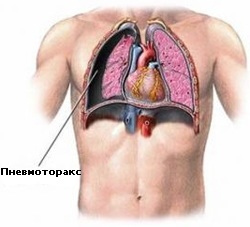Pneumothorax (from al-Greek. ő†őĹőĶŠŅ¶őľőĪ – breath, air and őłŌéŌĀőĪőĺ – chest) – the accumulation of air or in the pleural cavity. Occurs in perfectly healthy people with trauma, coughing, sneezing, or even without any apparent reason – the primary, may also be a complication of lung disease – secondary.
The symptoms of pneumothorax basically – it’s a pain in the chest and shortness of breath. For diagnosis, in most cases, only doctor is needed, ¬†to confirm it – X-ray study of alternate methods, or computed tomography (CT). In some situations, pneumothorax leads to severe hypoxia (lack of oxygen) and the decrease in blood pressure, progressing to cardiac arrest in the absence of treatment, a condition called tension pneumothorax.
Mild form of spontaneous pneumothorax usually doesn’t requires additional medical treatment. At voltages prevmotorakse, air from the pleural cavity should be evacuated, for example through Byulau¬†drainage.
Classification
- Spontaneous (spontaneous) – Breaking the pulmonary alveols:
- primary – in the absence of clinically significant pulmonary disease,
- secondary – a complication of an existing lung disease (tuberculosis, bullous emphysema, etc.).
     2. Traumatic Рwith injuries of the chest:
- penetrating chest trauma,
- blunt chest trauma.
     3. Iatrogenic Рcomplication of diagnostic or therapeutic interventions:
- after puncture of pleural cavity
- after central venous catheterization,
- after thoracentesis and pleural biopsy,
- after endoscopic transbronchial lung biopsy,
- due to barotrauma.
Types of pneumothorax
According to communication with the environment:
- Closed pneumothorax. In this form the pleural cavity gets a small amount of gas that is not growing. Communication with the external environment is missing. Considered to be the easiest type of pneumothorax, because the air can potentially disappear from the pleural cavity by its own.
- Open pneumothorax. Pleural cavity is communicating with the external environment, so it creates a pressure equal to the atmospheric pressure. May be accompanied by a hemothorax.
- Valvular pneumothorax – the most menacing type of spontaneous pneumothorax. Valve structure is being formatted. Every breath gives extra air portion to pleural cavity, each of the respiratory movements in the pleural cavity pressure increases. Can lead to a shift of the mediastinum, which impairs their function, especially squeezing large vessels, suffering cardiac activity.
In addition, pneumothorax can be:
- Parietal – in the pleural cavity contains a small amount of gas / air, light is not fully extended, as a rule, is a closed pneumothorax.
- Full – light completely subsided.
- Encysted – occurs in the presence of adhesions between the visceral and parietal pleura, limiting the area of pneumothorax, less dangerous, may be asymptomatic, but can also cause more breaks and at the place of the lung tissue adhesions.
The mechanism
Air or gas can enter the pleural space from the outside (with an open chest injury and communication with the external environment) or from internal organs (eg, traumatic rupture of lung injury in a closed, or at break emphysematous bubbles, “bull”, with minimal trauma or cough, spontaneous pneumothorax). Normally mild straightening due to the fact that the pressure in the pleural space is negative. Therefore, when getting into the air easily subside.
Treatment
If you have a suspicion of spontaneous pneumothorax, immediate call medical emergencies.
Open pneumothorax should be converted into closed by applying bandages (cellophane, oilcloth).
Pneumothorax valve must be set to open to reduce the pressure in the chest cavity, perform pleural puncture needle toast in the 2nd intercostal space (test the first rib is impossible, it is under the collarbone) to the mid-clavicular line on top of the ribs, as under the lower edge are nerves and blood vessels, damage of which will not improve the patient’s condition.
